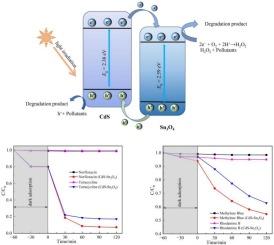Construction and photodegradation performance of CdS-Sn3O4 heterojunction
IF 4.7
3区 化学
Q2 CHEMISTRY, PHYSICAL
Journal of Photochemistry and Photobiology A-chemistry
Pub Date : 2025-09-27
DOI:10.1016/j.jphotochem.2025.116811
引用次数: 0
Abstract
A uniformly distributed photocatalytic composite material CdS-Sn3O4 heterojunction was constructed. Mixed valence tin oxide Sn3O4 was selected as a co-catalyst to improve the stability and photocatalytic activity of the composite because Sn3O4 possesses adjustable band gap and matches well with the CdS band position. The characterizations of EDS and XPS proved that Sn3O4 was successfully loaded on CdS. The composite material exhibits an excellent band gap of 2.25 eV, a high photo-generated current intensity and good photoluminescence properties. Due to the timely transfer of photo-generated electrons from CdS material to Sn3O4, the recombination of electron and hole is reduced, resulting in significant increase of photocurrent density and photocatalytic efficiency. The photocatalytic degradation experiments show that CdS-Sn3O4 possesses a significant degradation effect on antibiotics norfloxacin and tetracycline. Simultaneously, it also exhibits certain degradation effects on organic dye pollutants methylene blue and Rhodamine B. The active substances analysis shows that H2O2 and hole (h+) are the main active substances. Composite CdS-Sn3O4 still maintains a stable structure and good photocatalytic activity after several photocatalysis cycles. In brief, this heterojunction material is promising in water treatment and environmental protection.

CdS-Sn3O4异质结的构建及光降解性能
构建了一种均匀分布的光催化复合材料CdS-Sn3O4异质结。选择混合价氧化锡Sn3O4作为助催化剂,以提高复合材料的稳定性和光催化活性,因为Sn3O4具有可调节的带隙,并且与CdS带的位置匹配良好。EDS和XPS的表征证明了Sn3O4被成功加载到cd上。该复合材料具有2.25 eV的优异带隙、较高的光生电流强度和良好的光致发光性能。由于光生电子从CdS材料及时转移到Sn3O4上,减少了电子与空穴的复合,光电流密度和光催化效率显著提高。光催化降解实验表明,CdS-Sn3O4对抗生素诺氟沙星和四环素具有显著的降解作用。同时对有机染料污染物亚甲基蓝和罗丹明b也有一定的降解作用。活性物质分析表明,H2O2和空穴(h+)是主要的活性物质。复合CdS-Sn3O4经过多次光催化循环后仍保持稳定的结构和良好的光催化活性。总之,这种异质结材料在水处理和环境保护方面具有广阔的应用前景。
本文章由计算机程序翻译,如有差异,请以英文原文为准。
求助全文
约1分钟内获得全文
求助全文
来源期刊
CiteScore
7.90
自引率
7.00%
发文量
580
审稿时长
48 days
期刊介绍:
JPPA publishes the results of fundamental studies on all aspects of chemical phenomena induced by interactions between light and molecules/matter of all kinds.
All systems capable of being described at the molecular or integrated multimolecular level are appropriate for the journal. This includes all molecular chemical species as well as biomolecular, supramolecular, polymer and other macromolecular systems, as well as solid state photochemistry. In addition, the journal publishes studies of semiconductor and other photoactive organic and inorganic materials, photocatalysis (organic, inorganic, supramolecular and superconductor).
The scope includes condensed and gas phase photochemistry, as well as synchrotron radiation chemistry. A broad range of processes and techniques in photochemistry are covered such as light induced energy, electron and proton transfer; nonlinear photochemical behavior; mechanistic investigation of photochemical reactions and identification of the products of photochemical reactions; quantum yield determinations and measurements of rate constants for primary and secondary photochemical processes; steady-state and time-resolved emission, ultrafast spectroscopic methods, single molecule spectroscopy, time resolved X-ray diffraction, luminescence microscopy, and scattering spectroscopy applied to photochemistry. Papers in emerging and applied areas such as luminescent sensors, electroluminescence, solar energy conversion, atmospheric photochemistry, environmental remediation, and related photocatalytic chemistry are also welcome.

 求助内容:
求助内容: 应助结果提醒方式:
应助结果提醒方式:


